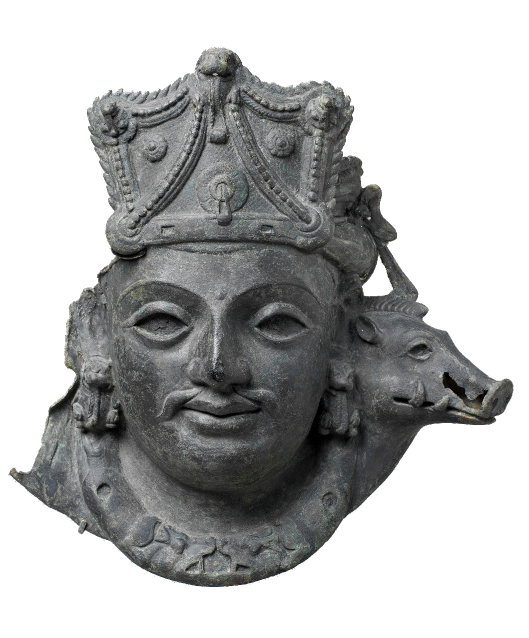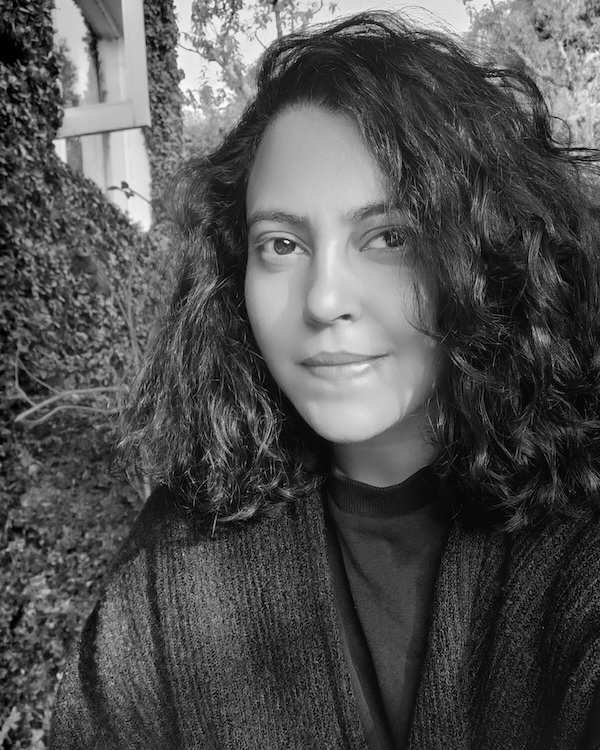PERSPECTIVES
Speculative Futures and Cultural Pasts: An Interview with Artists Murthovic and Thiruda
Weaving ancient art into digital play is like a delicate dance, one that involves a precarious balance of possibility and legacy. But perhaps, the weight of cultural heritage feels lighter when reimagined along an alternative frequency, where the music wafts easy and the high-wire act is a fun trip from the past to the future.
I was witness to one such act of electronic climate fiction in March 2025 — think a sci-fi film with an immersive interface and interactive elements — played under the spring moon in Delhi, where a ‘cultural cyborg’ named Meenakshi navigated the worlds of science, society, and art in the post-apocalyptic India of 2079 AD. While the protagonist was on a mission to save culture in a transforming world, I wondered if this virtual crusade could bring about real change.
Through their performative practice converging cultural histories, Carnatic-electronic music, generative Al, e-gaming, and speculative storytelling, transmedia artists Avinash Kumar aka Thiruda and MSR Murthy aka Murthovic bring cultural objects out for public play via a virtual museum, instead of relegating these to the status of relics.
Over the years, they have wielded data as a powerful tool through various experimental channels, including live performances viewed with 3D glasses, immersive audio-visual installations, virtual reality cinema, and art-gaming.
Their initiatives include Elsewhere in India, EyeMyth Festival, Antariksha Studio, Unbox; exhibits such as Resonance Continuum, ongoing at the Barbican Centre in London, and collaborative work with the British Council and NEW INC, the New Museum’s incubator, over the past few years.
One of their significant innovations is an integration called Antara — a playable world embedded within the popular online game Fortnite, full of objects referencing India’s cultural past.
Doubtless, visual storytelling, dance, music, and play have always transcended the limitations of language and pedagogy as mediums of active awareness and participation. But while fantasy is a potent foreteller, the counter-argument is that it may potentially disorient one from the urgent present, or lead to despair and delusion, especially in the age of doom-scrolling. Here, Thiruda and Murthovic are clear to maintain a post-dystopian, or post-cyberpunk outlook that approaches the world with optimism and solutions through sustainable technologies, renewed nature, and cultural harmony — also known as the subculture of ‘solarpunk.’
Examining this tightrope act between preservation and artistic evolution, I spoke with Murthovic and Thiruda about their practice and approach.
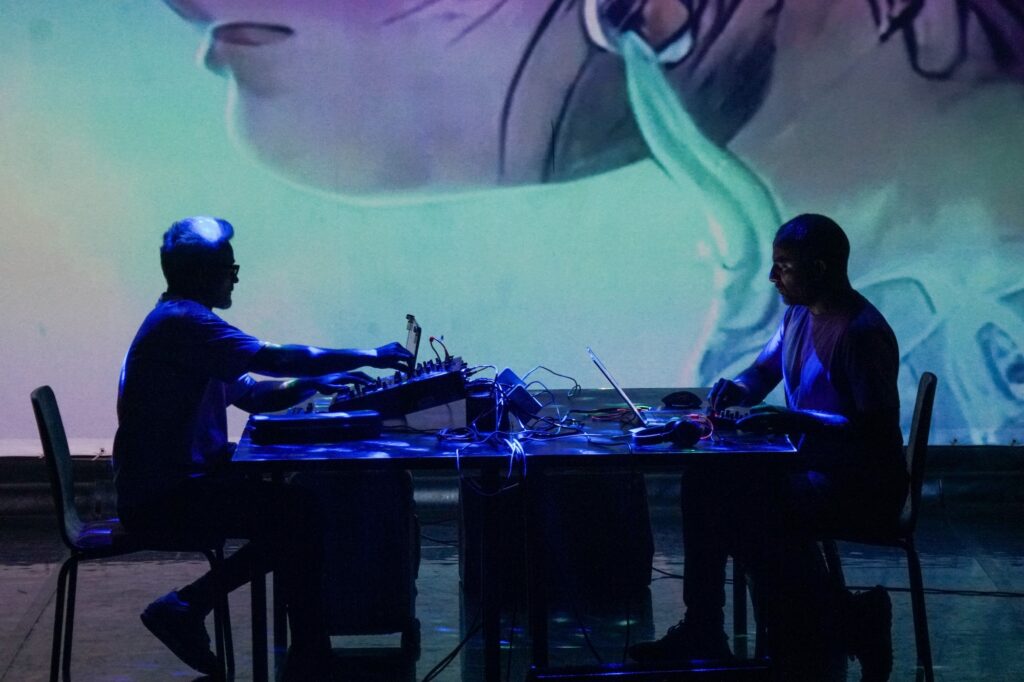
Soumya Mukerji: Is culture, as we know it, on the brink of extinction – or extension? Can you elaborate on the solarpunk era and its related synergies with Indian culture?
Thiruda: Culture is neither dying nor simply extending — it’s transforming. We’re witnessing a cultural metamorphosis, where traditional forms aren’t disappearing, but finding new vessels. In our work, Meenakshi represents this evolution — a cultural cyborg who preserves essence while adapting form. The solarpunk movement aligns beautifully with the Indian philosophy of harmony between technology and nature. Ancient Indian texts already imagined advanced civilisations that lived symbiotically with their environment. We’re not creating alien futures but rediscovering forgotten wisdom.
Murthovic: It is extension, I think; evolution for sure. And I see it happening through sound, all the time. When we record folk musicians in remote places and later find new contexts to preserve them, it’s culture extending into newer spaces of existence. In the Indian music traditions, we view raga as a living entity, constantly reinterpreting itself, finding new contexts or compositions to extend its space. Solarpunk’s optimistic technology mirrors the inherent optimism of music philosophies in our land.
Mukerji: What sparked this partnership, and how do you intend to bridge the critical gap between the past and the future with your transdisciplinary practice?
Murthovic: Avi and I kept crossing paths in Delhi’s electronic music scene, but the real spark came from recognising our shared struggle. We both grew up between worlds — traditional Indian households with global musical influences. Our secret isn’t alchemy; it’s archaeology, really. Digging for inspiration in our cultural past to see what it holds for the future.
Thiruda: The gap isn’t critical — it’s creative. My mother, Jayalakshmi Eshwar, performing Bharatanatyam for over fifty years, showed me that classical arts are inherently futuristic. Every mudra contains computational logic, every rhythm predicts electronic patterns. Our transdisciplinary approach simply reveals connections that were always there. We’re not bridging past and future; we’re proving they’re the same continuum.
Mukerji: I’m intrigued by the philosophy that the classical is, in fact, a form of futurism…
Murthovic: There is no doubt that when ancient Indian music traditions were built on the frameworks for infinite improvisation within structured rules, a paradox of the known and the unknown, they were designing the future of human-machine collaboration. We’re not making classical music futuristic. Our methodology may just be revealing its inherent futurism.
Thiruda: Bharatanatyam’s mudras are the world’s first gestural interface. Each hand position communicates complex concepts —essentially ancient UX design. When Meenakshi uses mudras to interface with AI systems, she’s using technology’s most ancient form. Classical arts are prototypes for contemporary innovation, not relics requiring modernisation.
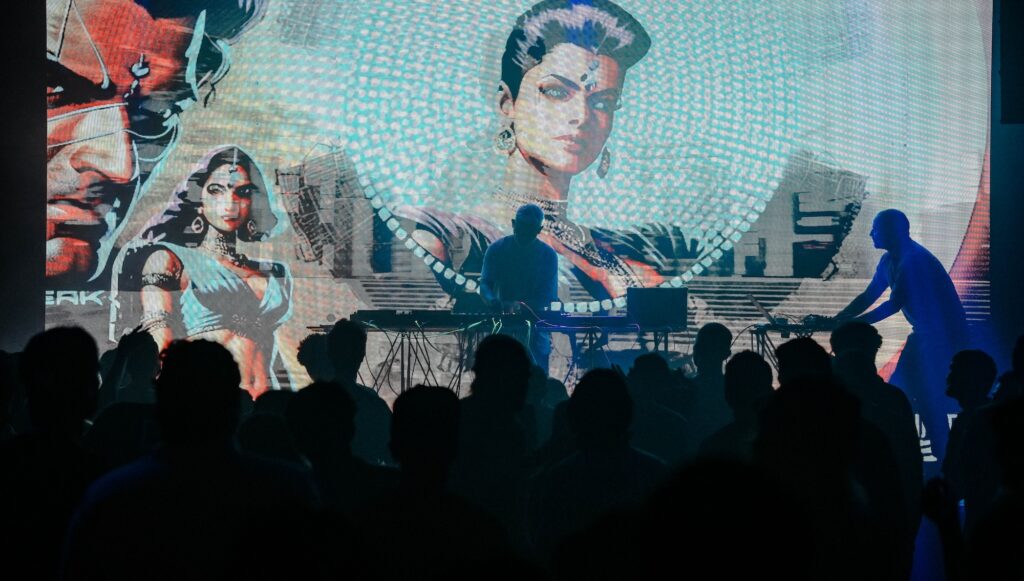
Mukerji: What role can extended reality [XR] play in the post-contemporary cultural and climate renaissance?
Thiruda: XR becomes a vessel for embodied knowledge. In Meena XR [an extended reality experience where players embody the cultural cyborg Meenakshi and communicate through Indian dance mudras], when someone performs a mudra and triggers responsive AI content, they’re not just learning—they’re participating in cultural continuity. XR democratises access to gurus and traditions that geography might otherwise limit. It’s not about replacing physical learning but expanding its reach.
Murthovic: We continue to realise the true potential of XR in the process of cultural revival and archiving of all forms, especially sound. For climate renaissance, XR lets us experience future scenarios viscerally, not just intellectually. When people hear how forests might sound in 2079 through our soundscapes, we hope to bring that soundscape out of abstraction and into reality.
Mukerji: Play is power. What are your thoughts on immersive, interactive, and collaborative e-games as a significant agent of action and sustainable change?
Thiruda: Our Fortnite island Antara proves this daily. Young gamers worldwide explore Indian heritage not because they’re forced to learn, but because discovery feels like adventure. When 12-year-olds in different countries collaboratively solve puzzles using Indian cultural artefacts, they’re unconsciously building global cultural literacy. Play bypasses resistance to learning.
Murthovic: Games create emotional investment. In our musical gaming experiences, when players successfully complete a raga sequence, they feel a sense of accomplishment, not just intellectual understanding. I think this emotional connection drives behavioural change more effectively than any lecture about cultural preservation — power lies in making complex systems feel intuitive and rewarding.
Mukerji: What are the challenges of world-building while keeping realities and responsibilities in mind?
Thiruda: The biggest challenge is avoiding cultural appropriation of your own culture. When we use AI to generate ‘future Indian’ imagery, we must ensure we’re not perpetuating colonial stereotypes or creating new ones. Every speculative choice carries responsibility. We constantly ask: ‘Does this future feel extractive or generative?’
Murthovic: Fantasy can become escapism if we’re not careful. Our post-cyberpunk approach deliberately avoids dystopian despair. We create hopeful futures not through denial of current problems, but by imagining how traditional wisdom might solve them. The responsibility is showing that progress doesn’t require abandoning roots.
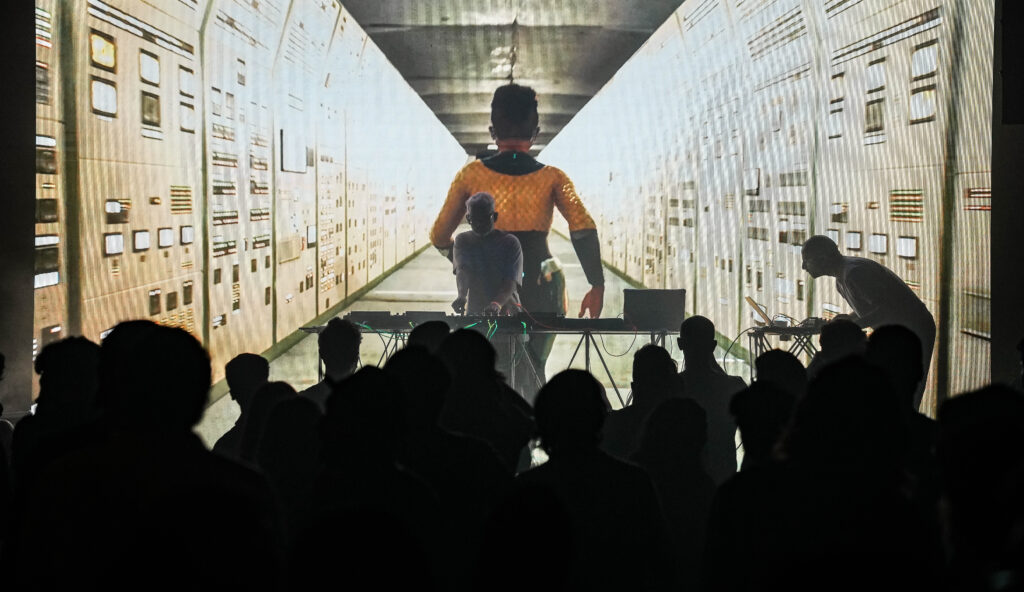
Mukerji: Do you think your narratives have the potential to impact diverse and marginalised communities powerfully?
Thiruda: Our Fortnite islands reach communities we never could through traditional venues. Rural Indian kids with smartphones access the same content as urban art students. When marginalised communities see their cultural elements celebrated in global gaming platforms, it reverses historical power dynamics. Representation in speculative futures is political action.
Murthovic: Sound transcends language barriers. Our field recordings from tribal musicians in Northeast India, transformed through electronic production, let marginalised voices participate in global conversations about future culture. We’re not speaking for communities — we’re amplifying their existing innovations in new contexts.
Mukerji: As much as data-driven technologies impact the environment, do you think data as storytelling can also save the day?
Murthovic: Every field recording we make preserves acoustic environments that might vanish. Sometimes it’s not about capturing the ephemeral. Sometimes it is an important footnote in cultural history. That’s why I believe that digital preservation, done thoughtfully, creates abundance from scarcity. We hope our sound archives become biodiversity banks for future generations.
Thiruda: The key is conscious data use. Instead of mindless content generation, we create purposeful cultural algorithms. Our AI models trained on Indian imagery don’t just produce visuals — they preserve visual languages. When data serves cultural continuity rather than mere entertainment, it becomes regenerative technology.
Mukerji: Earlier this year, the curator Hans Ulrich Obrist told me what the world really needs is a dedicated sonic museum. How can we change the frequency of our futures by harnessing the power of sound?
Murthovic: Obrist is right — we need sonic museums. Different frequencies literally alter consciousness. Our work with alternative tuning systems, moving beyond Western 12-tone equal temperament, opens new emotional territories. When we tune electronic music to classical Indian scales, we’re not just being culturally authentic, we’re accessing different states of being.
Our responsibility as sound artists is conscious frequency curation. The frequency of our future depends on which sounds we choose to amplify.
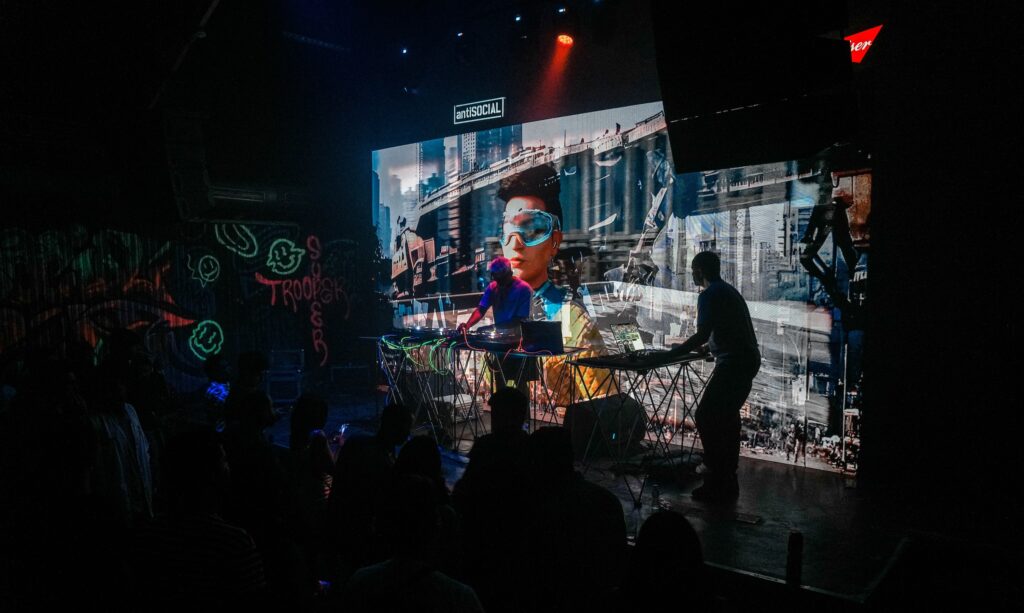
Mukerji: Where does your evolving story go from here and what are the questions you find yourself asking? What happens when the last surviving cultural cyborg must make way?
Thiruda: Meenakshi’s story suggests that preservation requires distribution, not hoarding. If she’s the last cultural cyborg, her mission becomes teaching others to become cultural cyborgs too. The future isn’t about singular heroes but distributed networks of cultural memory.
Murthovic: We’re building systems that outlast us. Our modular compositions can be performed by future musicians who understand the frameworks but create new interpretations. The tools we create — like the Mudra Machine or our post-cyberpunk instruments — become cultural technologies for others to evolve.
Together, we’re asking: How do we remain human while becoming technological? How do we honour the past while imagining radical futures? How do we preserve culture not as museum pieces but as living systems? These questions will outlive any single project. Our work plants seeds for conversations we’ll never finish, and that’s exactly as it should be.
Soumya Mukerji is a senior journalist, educator, and poet probing convergent culture, arts, design, literature, climate, and humanities. She brings personal and poetic perspectives to storytelling through her multifaceted work.
